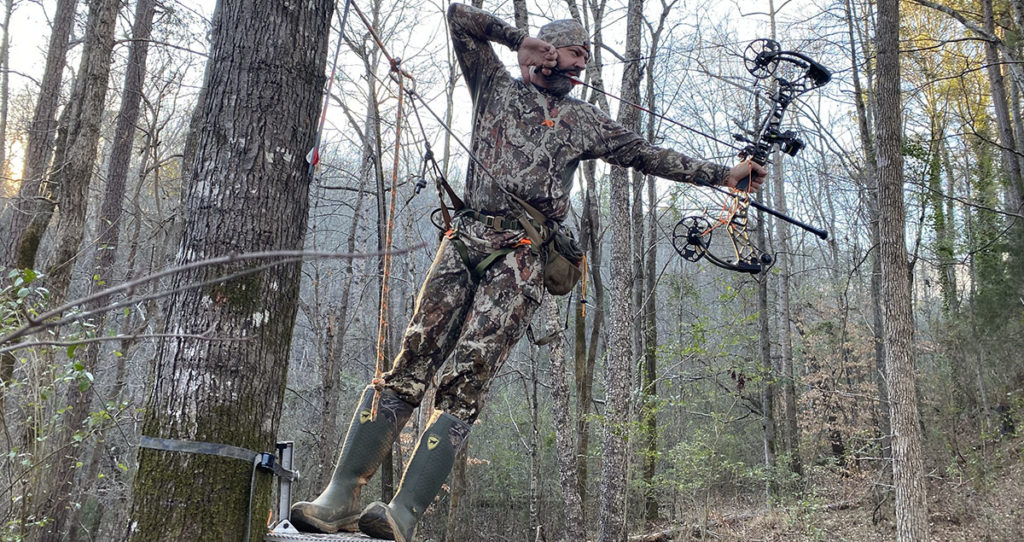16 Saddle Hunting Tips From Experienced Saddle Hunters
Even with two seasons of saddle hunting under my belt, I’m still learning and tweaking my setup all the time. I’ve learned a few tips along the way I can pass along to new saddle hunters, but for the purpose of this article, I wanted to reach out to those with more experience to pass along the best advice possible.
I posted a request for tips in two large saddle hunting Facebook groups and was ecstatic to get well over 200 responses from some very experienced hunters, including John Eberhart himself.
There were a lot of duplicate responses, and most of the tips could be organized into one of three categories:
Within those three categories, I have combined and condensed the responses into what I consider the 16 best saddle hunting tips for a new saddle hunter. My hope is that these tips will help you avoid some of the common saddle hunting mistakes that many saddle hunters make.

By far, the number one response was to spend time practicing with your saddle hunting gear. But the responses varied enough, that I was actually able to break them into seven different tips.
1. Practice setting up
My number one tip based on personal experience, and the responses I got from experienced saddle hunters, is to practice a lot before ever hunting from a saddle. From making the climb to hanging your platform, and getting all your gear organized in the tree, you’ll want to develop a step-by-step process that becomes second nature by the time deer season rolls around.
2. Practice at a low height
This next tip is similar to the first, but in this case, you’re just setting up a foot or two off the ground and practicing moving around in the saddle. Hunting from a saddle is completely different from any other style of hunting, and it takes time to get comfortable with maneuvering around into different positions that may be necessary to make a shot. These maneuvers are best practiced close to the ground just in case something were to go wrong.
3. Practice shooting
As I mentioned above, hunting from a saddle is very different than hunting from a traditional stand — and that includes the shooting aspect. Again, while set up just a foot or two off the ground, get comfortable shooting in all directions. You’ll quickly find it’s much easier to shoot in certain directions than others. You want to ensure that regardless of which way that buck you’re after comes in, you’ll be prepared to make the shot.
4. Practice in the dark
This is one I wouldn’t have thought of myself, but a couple of saddle hunters mentioned the importance of practicing your setup routine in the dark. That’s great advice. Setting up or tearing down in the dark with minimal light adds an extra level of difficulty to the process. And there will certainly be times you set up before daylight in the morning and times you’ll be climbing down and packing up after dark in the evening. You don’t want your first experience doing so to be opening day of deer season.
5. Practice wearing cold-weather gear
This was another great piece of advice that could easily be overlooked. Saddles and jackets don’t go together really well, so it’s important to practice wearing the saddle with cold-weather clothes. In addition to just making sure you practice wearing the saddle with heavy clothes, you’ll also want to practice climbing and getting setup with those same clothes. That way there are no surprises when that first big cold front of the year arrives.
6. Find your saddle sweet spot
One of the challenges of saddle hunting is staying comfortable on those long hunts. Some of that comfort can be controlled by adjusting the height of your tether rope on the tree as well as the length of your saddle’s bridge rope. While you’re practicing setting up and maneuvering in your saddle preseason, make small adjustments to both to find the sweet spot that keeps you most comfortable.
7. Don’t judge saddle hunting by your first few sits
This is definitely one of my key pieces of advice for new saddle hunters, and several of the experienced saddle hunters I talked to were quick to mention this as well. It takes time to get used to hunting from a saddle. As odd as it may sound, your body has to get in “saddle shape,” and the only way to get there is with practice and time in the saddle. Allow yourself a half dozen hunts before making any long-term decisions on whether saddle hunting is right for you. If I would have made a decision based on my first experience in the saddle, I would probably be back to packing in my climber every hunt.
8. Try different saddles
Among the 200+ tips we got from saddle hunters, a close second to practicing your setup was trying different saddles before dropping your hard-earned money on one. Saddles aren’t cheap, and just because a particular saddle works well for me doesn’t mean it will work for you. Reach out to other saddle hunters, or attend some of the try-before-you-buy events that some saddle-hunting manufacturers now host to try as many different models as possible before you spend your money.
This is just one of several tips we cover in our article on making saddle hunting as comfortable as possible.
9. Don’t buy cheap
Not only do you want to try different models of saddles before buying, but you’ll want to buy the best saddle you can afford. The old adage “you get what you pay for” holds true for tree saddles. And since your life depends on that saddle, it’s not something you want to skimp on.
10. Don’t buy accessories you don’t need
As we already established, saddle hunting isn’t cheap. So the last thing you want to do is drop money on gear you don’t really need or won’t use. So my advice for new saddle hunters is to keep it simple. There’s only five pieces of gear you need to start saddle hunting. Beyond that, I wouldn’t worry about many accessories until you have some time in the saddle to see what you actually need.
11. Buy some good knee pads
While not all accessories are necessary, a good set of knee pads or a cushion you can strap to the tree is absolutely necessary if you’re going to spend any time sitting in your saddle. Sitting with your knees against the bark of a tree gets uncomfortable quickly. Having those knee pads or a cushion will save you a lot of discomfort without adding too much weight to your overall setup.
12. Inspect all your gear every hunt
This is great advice that I’ve been guilty of not practicing myself. Your life depends on your gear staying intact, so it makes sense to check it over carefully before every hunt. Make sure none of the stitching on your saddle is coming loose or that none of your ropes are fraying. You’ll also want to check the condition and functioning of your carabiners and Ropeman (if you’re using them). If there’s ever any question about whether your equipment is safe to use, then err on the side of cause and replace it.
13. Take your time. It’s not a race.
This was a common response among those 200+ saddle hunters that submitted their best tips. It doesn’t matter how fast you can get set up in a tree, because it isn’t a race. There’s no prize for the winner.
Your life is at stake here.
Develop your routine as we discussed earlier, and follow it each and every time. Take your time, as there is no room for mistakes here. Complacency kills.
14. Lock your carabiner every time
This is a simple but often overlooked step. Make sure your carabiner is locked in place every time so there’s no chance of your bridge rope coming out while you’re up in the tree. And while we’re talking about carabiners, make sure you’re buying quality gear rated for climbing. Not some cheap knockoff from Amazon, Walmart, or Home Depot.
15. Think about where the deer will come from
When saddle hunting, it’s much easier to shoot in some directions than others. With that in mind, it’s important to set up in a way that the deer will most likely come from behind the tree and pass by on your strong side (your left if you’re a right-handed shooter). Otherwise, you may be forced to quickly maneuver yourself to make a much more difficult weak-side shot.
16. Think cover
We’ll finish things off with an important lesson of saddle hunting: when setting up, cover is more important than overall height. When I first started saddle hunting, I was a little concerned about only having three climbing sticks. Even with long legs and a one-step aider on each stick, I could only get around 15-18 feet high.
In two years of saddle hunting, though, that has rarely been an issue. I look for trees with cover around that 12-15 foot mark, and they are seldom hard to find. In some cases, I’ve only been 8-10 feet off the ground, but I had decent cover in the form of branches and leaves to break up my outline. That seems to be more effective than being 20+ feet high with no cover.
So, when looking for a place to set up, look for trees that will provide good cover, and let that cover dictate how high you hunt.
Summary
Saddle hunting is a whole new ballgame for most hunters, and the learning curve can be steep. It’s my hope that these 16 tips will help shorten the curve and make you a better, safer, and more successful saddle hunter. Good luck this season!

Wow you almost got them all! Only one I can think of is WIND . I love being able to go to any of my hunting areas and not worry about the wind until I get there, checking on the phone, check it in real time and go pick a tree into the wind. Can’t do it with a fixed stand, and tough to do even with a climber.
Thought you all would forget about tree cover, but you didn’t.
Once I decide on the wind Direction, that’s the second thing I look for is a tree with limbs and leaves 12 to 15 feet up.